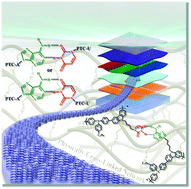Complementary hydrogen bonding interaction-mediated hole injection in organic light-emitting devices†
Abstract
Nucleobase-functionalized conjugated polymers (NCPs) utilize molecular self-assembly to spontaneously arrange into three-dimensional supramolecular polymer networks through complementary multiple hydrogen bonding interactions. NCPs behave as a highly efficient optoelectronic material with substantially enhanced overall physical properties, making them highly attractive for a wide range of optical and electronic applications. Due to the ease of varying the extent of the reversible network by tuning the complementary base pairing content, these newly-developed NCPs could be easily tailored to meet specific requirements with respect to thermal stability, optical properties and energy band gaps for the fabrication of organic light emitting diode (OLED) devices. When NCPs were employed as the hole injection layer (HIL) in a solution-processed three-layer OLED device, a low turn-on voltage (2.9 V), maximum brightness as high as ∼52 000 cd m−2 and a luminous efficiency of 9.7 cd A−1 were achieved; these values were much higher than those of control samples and conventional HIL-based devices. Thus, this new system provides a new direction to further improve the hole-injection ability of conjugated polymers and hence offers opportunities towards the design and development of high-performance multilayer OLED devices.



 Please wait while we load your content...
Please wait while we load your content...